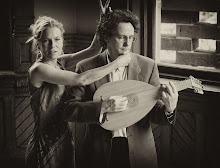 |
| 'Really?' |
In the class we began by singing Lachrimae/Flow my tears from John Dowland’s Second Book of Songs, the melancholy poet of which has many parallel symptoms with Hamlet. Download us singing that here if you haven't already.
 |
| The Class |
 |
| Two gentlemen showing off their Ancient Humanist learning and wearing trendy black. Gertrude - 'Good Hamlet, cast thy nighted color off...' |
Then we went on to talk about Ophelia’s songs, which we've thought about a lot with Prof. Deanne Williams. The 'bad quarto', the first print of Hamlet has her entering with a lute in hand. While it may be deficient in other ways (or it may just represent the play for a different context at the Inns at Court rather than the Globe) this direction is important. When she starts singing songs that a well educated young lady shouldn't have is becomes very much so. As an example of what a young lute-learning women should be singing we sang Coy Daphne fled/Chaste Daphne fled (a 2 for 1 song with different texts that praise and mock chastity) and Like as the Lute (a kind of patchwork quilt of musical definition demonstrations for the lute song student) from John Danyel’s songbook dedicated to Miss Anne Green. In the dedication he specifically says the songs were composed for her to sing.
 |
| A Ballad on the tune of Robin, (which Ophelia sings a snippet of with its original words) on the topic of a rich powerful trying to get his way with a young woman. |
Ophelia, though, sings, with her lute in hand some of the rudest ballad songs. But not only that, we found that the texts she sings that appear to be less rude are actually associated with other near-contemporary ballad texts that where an older, richer man seduces, or attempts to seduce, a younger woman. Would the audience at the original performances have been saying ‘Oh, she’s singing that tune that has the other words of The princely wooing of the fair maid of London by King Edward’ (to the tune of Robin is to the Greenwood Gone) and ‘Oh, that’s the one that has the other words where the rich merchant is trying it on with Bess the farmer’s wife’ (to the tune of Walsingham)?
Then it was back to the hotel to get cleaned up for the concert.
 |
| The palm at the end of the mind, Beyond the last thought, rises... This one's only at the end of the driveway of the Sheraton, though. |
The Dean of the Division of Arts and Humanities presents
When Silly Bees Could Speak
Music by John Dowland for the 450th anniversary of his birth
Recital Hall, Conrad Prebys Music Center,
University of California San Diego
6PM - May 21st 2013
John Dowland (1563-1626)
It was a time when silly Bees could speak.
Dye not before thy day
Times eldest sonne, old age the heyre of ease: First part
Then sit thee downe, & say thy Nunc demittis: Second part
When others sings Venite exultemus: Third part
Lachrimae pavan
The Right Honourable Robert, Earl of Essex, his Galliard
The most sacred Queene Elizabeth, her Galliard
Sweet stay awhile, why will you rise?
If my complaints could passions move
Semper Dowland Semper Dolens
Sir John Smith his Almaine
A Sheperd in a shade his plaining made
Sorrow sorrow stay, lend true repentant teares
Solus cum sola
The Right Honourable the Lady Rich, her Galliard
Frog Galliard
Thou mighty God 1. part
When Davids life by Saul 2. part
When the poore Criple 3. part
Preludium
Lady if you so spight me
In darknesse let mee dwell
 |
| Our glamourous green room. |
‘My Lord of Essex chose to evaporate his thoughts in a sonnet (beeing his common way) to be sung before the Queene, (as it was) by one Hales, in whose voice she took some pleasure.’ Sir Henry Wotton wrote this some 40 years after the execution of Robert Devereaux, the Earl of Essex, in a pamphlet comparing him to another spectacular courtier who met an untimely end, the Duke of Buckingham, the ‘favourite’ of James I. But it would be very rare, even impossible, for Essex and Elizabeth to ever be alone together; court ceremony meant that the ensemble called the Lutes and Voices served right in the Queen’s bed chamber along with all the other courtiers and servants. So any courtier’s poem sung before the queen was to some degree a semi-public self-serving self-fashioning. This is most explicit in Dowland’s setting of Essex’s poem ‘It was a time when silly Bees could speak’, called The Earl of Essex, his Buzz’ in poetic sources, where Essex, punning heavily on thyme/time, complains to the queen bee that he is not getting his just reward for all the time he puts in getting nectar from the thyme.
 |
| There are no bees, silly or otherwise, in this flower. It is not thyme. |
But it was not only male courtiers who were projecting an image through song and poem. Dowland’s Second Book of Songs, which cements his position as the official composer of Elizabethan Melancholy, was dedicated to Lucy Countess of Bedford who also was the patron of Ben Jonson, John Donne and Samuel Danyel. Did she engage these artists because she was drawn to their work in the melancholy milieu or was Elizabethan and Jacobean melancholy made to order for the woman who wanted to bring light (Lucy) to these dark artists?
 |
| Hallie, John and Seth by a Triton, mascot of UCSD 's sports teams. |
And on the third day...
 |
| Home again, home again, market is done. |



